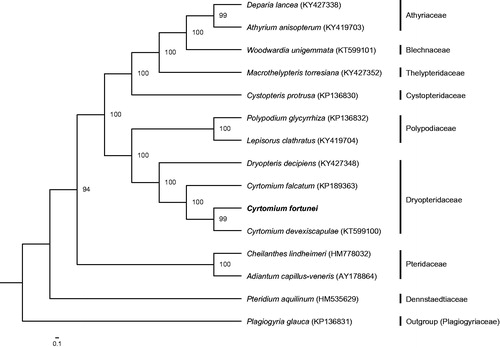Abstract
The complete chloroplast genome of an important medical fern Cyrtomium fortunei has been sequenced. Its genome is 151,699 bp in length with a pair of inverted repeats (IRs, 23,875 bp), separated by a small single copy region (SSC, 21,625 bp) and a large single copy region (LSC, 82,324 bp). It contains 132 genes, covering 88 protein coding genes, 35 tRNA genes, eight rRNA genes, and one pseudogene. Maximum likelihood analysis indicates that the phylogenetic tree is monophyletic with three clades. Cyrtomium fortunei is closely related to C. devexiscapulae, which further forms a sister clade to C. falcatum.
Cyrtomium fortunei J. Smith (syn.: Polystichum fortunei Nakai) belongs to Dryopteridaceae and is known as holly fern. Its distinctive features are simply ovate-oblong pinnate leaves composed of dull green sickle-shaped pinnae with fairly smooth margins (Zhang et al. Citation2013). Cyrtomium fortunei is apomictic triploids (n = 2n = 123) (Takamiya Citation1996; Ootsuki et al. Citation2011), growing in limestone crevices in open areas or forests with altitude 100–2400 m (Zhang et al. Citation2013). The rhizomes of this fern, called Guan-zhong in China (China Food and Drug Administration Citation2015), have been widely used as a traditional medicinal plant for clearing heat and damp, cooling blood and hemostasis, and insecticide (Cui and Liu Citation2014). However, because there are great confusions in original plants of Guan-zhong, including other species in Cyrtomium and other ferns, mixes or misuses obviously occur (Cui and Liu Citation2014). Furthermore, the delineation of species within Cyrtomium and phylogenetic relationships of the genus in ferns are not well solved (Lu et al. Citation2005, Citation2007). Therefore, acquirement of the complete chloroplast of C. fortunei has double meaning for identification of medicinal plants and phylogenetic analysis.
The samples of C. fortunei were obtained from Medical Plants Garden in Guangdong Food and Drug Vocational College, China (23°20’85.47’’N, 113°38’0.99’’E). The specimen is stored in Herbarium of Sun Yat-sen University (SYS; voucher: SS Liu 20161009). We isolated DNA from leaf tissues, which was further broken into 300 bp fragment using Covaris M220 (Covaris Inc., MS, USA). After paired-end library was constructed, whole genome sequencing was performed on Illumina Hiseq 2500. Trimmomatic v0.32 and Fastqc v0.10.0 were used to filter and trim reads, and visualize the quality of the clean reads, respectively. We assembled the complete chloroplast genome using Velvet v1.2.07 (Zerbino and Birney Citation2008). Annotation was separately performed with DOGMA and tRNAscan-SE to predict protein-coding genes (PCGs), transfer RNA (tRNA) genes, and ribosome RNA (rRNA) genes (Lowe and Eddy Citation1997; Wyman et al. Citation2004). The phylogenetic analysis was conducted based on chloroplast genomes of 15 ferns. Plagiogyria glauca was used as outgroup. A maximum likelihood (ML) tree was constructed using RAxML v.8.0 (Stamatakis Citation2014) with 1000 bootstrap replicates.
The complete chloroplast genome of C. fortunei is 151,699 bp in length with a typical quadripartite structure containing a large single copy (LSC) region of 21,625 bp, a small single copy (SSC) region of 82,324 bp, and a pair of 23,875 bp inverted repeat (IRa and IRb) regions (GenBank accession number: MG913607). The genome encodes 132 genes, covering 88 PCGs, 35 tRNA genes, eight rRNA genes, and one pseudogene. Of them, 14 are duplicated, including four PCGs (ycf2, psbA, rps7, and rps12), six tRNA genes (trnN-GUU, trnH-GUG, trnI-GAU, trnA-UGC, trnT-UGU, and trnR-ACG), and four rRNA genes (rrn5, rrn4.5, rrn23, and rrn16). The chloroplast genome is the typical AT rich (57.6%). The ML phylogenetic tree is monophyletic with three independent clades. Cyrtomium fortunei is closely related to C. devexiscapulae, which further forms a sister clade to C. falcatum with a strong bootstrap value of 100% ().
Disclosure statement
The authors declare no conflict of interests. The authors alone are responsible for the content and writing of the paper.
Additional information
Funding
References
- China Food and Drug Administration. 2015. The 10th Chinese Pharmacopoeia (ChP). Beijing: China Food and Drug Administration.
- Cui YX, Liu HG. 2014. The advance of the research on Cyrtomium fortunei. Mod Chin Med. 16:1043–1048. [in Chinese].
- Lowe TM, Eddy SR. 1997. tRNAscan-SE: a program for improved detection of transfer RNA genes in genomic sequence. Nucleic Acids Res. 25:955–964.
- Lu JM, Barrington DS, Li DZ. 2007. Molecular phylogeny of the polystichoid ferns in Asia based on rbcL sequences. Syst Bot. 32:26–33.
- Lu JM, Li DZ, Gao LM, Cheng X, Wu D. 2005. Paraphyly of Cyrtomium (Dryopteridaceae): evidence from rbcL and trnL-F sequence data. J Plant Res. 118:129–135.
- Ootsuki R, Shinohara W, Suzuki T, Murakami N. 2011. Genetic variation in the apogamous fern Cyrtomium fortunei (Dryopteridaceae). Acta Phytotaxon Geobot. 62:1–14.
- Stamatakis A. 2014. RAxML version 8: a tool for phylogenetic analysis and post-analysis of large phylogenies. Bioinformatics. 30:1312–1313.
- Takamiya M. 1996. Index to chromosomes of Japanese Pteridophyta. Japan Pteridol Soc. 68:12. [in Japanese].
- Wyman SK, Jansen RK, Boore JL. 2004. Automatic annotation of organellar genomes with DOGMA. Bioinformatics. 20:3252–3255.
- Zerbino D, Birney E. 2008. Velvet: algorithms for de novo short read assembly using de Bruijn graphs. Genome Res. 18:821–829.
- Zhang LB, Wu SG, Xiang JY, Xing FW, He H, Wang FG, Lu SG, Dong SY, Barrington DS, Iwatsuki K, et al. 2013. Dryopteridaceae. In: Wu ZY, Raven PH, Hong DY, eds., Flora of China. Vol. 2–3 (Pteridophytes). Beijing: Science Press; p. 541–724.

